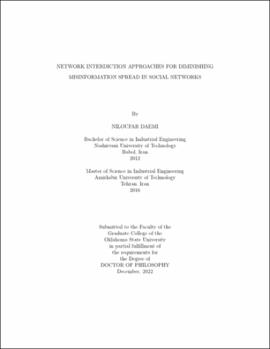| dc.contributor.advisor | Borrero, Juan S. | |
| dc.contributor.author | Daemi, Niloufar | |
| dc.date.accessioned | 2023-07-05T20:56:56Z | |
| dc.date.available | 2023-07-05T20:56:56Z | |
| dc.date.issued | 2022-12 | |
| dc.identifier.uri | https://hdl.handle.net/11244/337892 | |
| dc.description.abstract | Network interdiction has many applications in many domains, including telecommunications, epidemic control, and social network analysis. In this dissertation, we use network interdiction to devise strategies for the problem of misinformation dissemination in online social networks. These platforms provide the opportunity of quick communication between users, which in a network with malicious accounts can result in the fast spread of rumors and harmful content. We study this topic based on two different approaches. The first approach focuses on interdicting cohesive subgroups of malicious accounts. We use s-clubs, which are subsets of vertices that induce subgraphs of diameter at most s to model the cohesive social subgroups. We consider a defender that can disrupt the vertices of the adversarial network to minimize its threat, which leads us to consider a maximum s-club interdiction problem. Using a new notion of H-heredity in s-clubs, we provide a mixed-integer linear programming formulation for this problem that uses far fewer constraints than the formulation based on standard techniques. We further relate H-heredity to latency-s connected dominating sets and design a decomposition branch-and-cut algorithm for the problem. The second methodology that is studied in this dissertation is to delay the spread of misinformation in the network using first passage times interdiction. The first passage times are defined as the first time each user is exposed to a post shared by another user in the network and is computed using a discrete time Markov chain model. Vertices are interdicted to modify the transition probabilities and increase the propagation times between users who share misinformation and harmful content, and vulnerable users. We show that the problem is NP-hard and provide a mixed-integer linear programming formulation for it. Computational experiments on benchmark instances are conducted for both interdiction approaches based on cohesive subgroups and first passage times in order to assess the computational capabilities of the methods we introduced. | |
| dc.format | application/pdf | |
| dc.language | en_US | |
| dc.rights | Copyright is held by the author who has granted the Oklahoma State University Library the non-exclusive right to share this material in its institutional repository. Contact Digital Library Services at lib-dls@okstate.edu or 405-744-9161 for the permission policy on the use, reproduction or distribution of this material. | |
| dc.title | Network interdiction approaches for diminishing misinformation spread in social networks | |
| dc.contributor.committeeMember | Balasundaram, Balabhaskar | |
| dc.contributor.committeeMember | Buchanan, Austin | |
| dc.contributor.committeeMember | Chen, Charles | |
| osu.filename | Daemi_okstate_0664D_17937.pdf | |
| osu.accesstype | Open Access | |
| dc.type.genre | Dissertation | |
| dc.type.material | Text | |
| dc.subject.keywords | first passage time | |
| dc.subject.keywords | integer programming | |
| dc.subject.keywords | k-core | |
| dc.subject.keywords | Markov chain | |
| dc.subject.keywords | network interdiction | |
| dc.subject.keywords | s-clubs | |
| thesis.degree.discipline | Industrial Engineering and Management | |
| thesis.degree.grantor | Oklahoma State University | |
